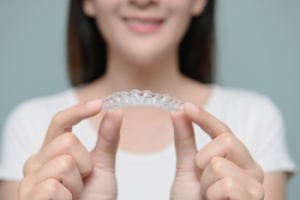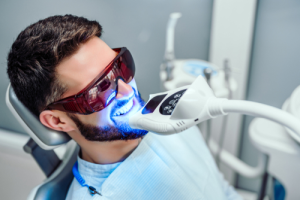What does Invisalign do? Benefits of Invisalign

What Is Invisalign?
Invisalign is a popular orthodontic treatment that utilises a set of clear, removable aligners to straighten teeth and correct various dental issues. Unlike traditional metal braces, Invisalign aligners are virtually invisible, making them a discreet and more aesthetically pleasing option.
The aligners are custom-made for each patient and slowly position the teeth into their desired places. Invisalign aligners are removable, allowing for easy cleaning, eating, and drinking. This innovative treatment option has gained popularity due to its convenience, comfort, and effective results in achieving a straighter and healthier smile.
What Does Invisalign Do?
Invisalign is a revolutionary orthodontic treatment that aims to straighten teeth and correct various dental issues. Using a series of clear, custom-made aligners, Invisalign provides a more discreet and comfortable alternative to traditional metal braces. Let’s delve deeper into what Invisalign does and how it can transform your smile.
Teeth Straightening:
The primary purpose of Invisalign is to straighten teeth. Whether you have crooked teeth, crowded teeth, gaps, or malocclusion (misaligned bite), Invisalign can address these issues. The treatment involves a series of aligners, each carefully crafted to gradually shift your teeth into their desired positions. By wearing the aligners as prescribed by your dentist, you can achieve a straighter, more aligned smile over time.
Customised Treatment:
Invisalign treatment begins with a comprehensive assessment of your teeth, bite, and overall dental condition. Advanced digital technology, including 3D imaging and scanning, is used to create a precise digital model of your teeth. Based on this model, a series of custom-made aligners are fabricated specifically for you. Each aligner is designed to fit snugly over your teeth and applies gentle, controlled forces to guide them into the desired positions.
Removable Aligners:
One of the key advantages of Invisalign is that the aligners can be removed as compared to traditional braces, which are fixed to the teeth. Invisalign aligners can be removed during eating, drinking, brushing, and flossing. This flexibility allows you to maintain good oral hygiene and enjoy your favourite foods without any restrictions. However, it’s important to note that aligners should be worn for the recommended 20-22 hours per day to ensure optimal treatment progress.
Virtually Invisible:
Invisalign aligners are made from clear, transparent plastic, making them virtually invisible when worn. This makes Invisalign a popular choice for those who want a more tactful orthodontic treatment option. Unlike traditional metal braces, Invisalign aligners do not draw unnecessary attention to your teeth, allowing you to feel more confident and comfortable throughout the treatment process.
Comfortable and Smooth:
Invisalign aligners are made from a smooth, BPA-free plastic material, providing a comfortable experience for the wearer. The aligners are customised to your teeth precisely, reducing any discomfort or irritation. While some mild pressure or tightness may be felt during the initial days of wearing a new set of aligners, most patients adapt quickly to the aligners and find them more comfortable than traditional braces.
Convenience and Fewer Dental Visits:
Invisalign treatment generally requires fewer dental visits compared to traditional braces. Instead of monthly adjustments, you will typically receive a few sets of aligners at a time and visit your dentist every few weeks for progress checks. This saves you time and minimises the inconvenience of frequent dental appointments, making Invisalign a convenient choice for busy individuals.
Improved Oral Hygiene:
Invisalign aligners can be easily removed for oral hygiene maintenance. You can brush your teeth as per your normal routine without the obstacles presented by traditional braces. With proper oral hygiene practices, such as regular brushing, flossing, and rinsing, you can maintain excellent dental health throughout your Invisalign treatment.
 Predictable Results with Virtual Treatment Planning:
Predictable Results with Virtual Treatment Planning:
Invisalign incorporates advanced virtual treatment planning software, which allows you to visualise the anticipated outcome of your treatment before it even begins. Through the digital models of your teeth, your dentist can show you a step-by-step simulation of how your teeth will move and the expected final result. This helps you have realistic expectations and understand the predicted outcome of your Invisalign treatment.
Versatility for Various Dental Issues:
In addition to straightening teeth, Invisalign can address a range of dental issues. These include overbite, underbite, crossbite, open bite, and gaps between teeth. Your dentist will assess your specific dental condition to determine if Invisalign is suitable for you and can effectively address your unique concerns.
Retention with Vivera Retainers:
Once your Invisalign treatment is complete, your dentist will provide you with Vivera retainers. These are custom-made, clear retainers that help maintain the position of your teeth and prevent them from shifting back. Wearing Vivera retainers as instructed by your dentist will ensure the long-term stability of your newly aligned smile.
Invisalign offers a modern and effective approach to teeth straightening and dental correction. With its customised, removable aligners, Invisalign provides a discreet, comfortable, and convenient orthodontic treatment option. By addressing various dental issues and providing predictable results, Invisalign can transform your smile, enhance your oral health, and boost your confidence. Consult with your dentist to determine if Invisalign is the right choice for you and embark on your journey towards a beautifully aligned smile.
How To Take Care Of Invisalign?
Proper care and maintenance of your Invisalign aligners are crucial for ensuring effective treatment and maintaining good oral health. Here are some essential tips on how to take care of your Invisalign aligners:
Clean Your Aligners Regularly:
To keep your aligners clean and free from bacteria buildup, it’s important to clean them regularly. Carefully brush your aligners with a soft toothbrush and non-abrasive toothpaste. Do not use hot water, as it can distort the shape of the aligners. Alternatively, you can use the Invisalign Cleaning Crystals or a denture cleaner recommended by your dentist.
Rinse Your Aligners Before Putting Them Back In:
Before reinserting your aligners after cleaning, rinse them thoroughly with lukewarm water to remove any cleaning solution residue. This ensures that your aligners are fresh and free from any lingering cleaning agents.
Avoid Eating or Drinking (Except Water) With Aligners In:
It’s important to remove your aligners before eating or drinking anything other than water. Food particles and beverages, especially those that contain colourants, can stain or discolour your aligners. Additionally, eating with aligners can cause damage or deformation to the aligners due to the pressure exerted while chewing.
Practise Good Oral Hygiene:
Maintaining good oral hygiene is crucial during Invisalign treatment. Brush your teeth properly after every meal before reinserting your aligners to prevent food particles from getting trapped between your teeth and aligners. Flossing is also essential to remove plaque and debris from between your teeth.
Store Your Aligners Properly:
When you remove your aligners, store them in their designated case. This protects them from damage or loss and helps maintain their cleanliness. Avoid placing your aligners in tissues or napkins, as they may accidentally get thrown away.
Keep Aligners Away from Heat and Sunlight:
Exposing your aligners to heat or direct sunlight can warp or distort them. Do not leave them in hot environments, such as a car on a sunny day or near hot water sources. Store your aligners in a cool, dry place to preserve their shape and integrity.
Remove Aligners with Caution:
When removing your aligners, do so gently to prevent any damage. Use your fingertips to carefully detach the aligners from your teeth, starting from the back. Avoid using excessive force or using sharp objects that can scratch or damage the aligners.
Attend Regular Check-Ups:
Follow your dentist’s recommendations for check-up appointments. These appointments allow them to monitor your progress, make any necessary adjustments, and ensure that your Invisalign treatment is progressing as planned. They can also provide guidance and address any concerns you may have regarding your aligners.
Avoid Smoking or Chewing Gum with Aligners In:
Smoking can cause discolouration of your aligners while chewing gum can stick to and damage them. It’s best to remove your aligners before smoking or chewing gum to maintain their cleanliness and integrity.
Follow Usage Guidelines:
It’s crucial to follow the usage guidelines provided by your dentist. Put on your aligners for the recommended 20-22 hours per day to ensure the treatment progresses effectively. Failure to wear your aligners as instructed can prolong the treatment duration and compromise the desired results.
By following these care tips, you can maintain the cleanliness, effectiveness, and longevity of your Invisalign aligners. If you have any concerns or questions about caring for your aligners, consult your dentist for guidance. Remember, proper care and maintenance play a significant part in the effectiveness of your Invisalign treatment and your oral health.
What Kind Of Dental Issues Does Invisalign Address?

Invisalign is a versatile orthodontic treatment that can effectively address various dental issues. Here are some common dental problems that can be solved or improved with Invisalign:
Crooked Teeth:
Invisalign can successfully manage mild to moderate cases of crooked teeth. The aligners apply gentle, controlled forces to gradually move the teeth into their desired positions, resulting in a straighter and more aligned smile.
Crowded Teeth:
In cases where there is insufficient space in the jaw for all the teeth to properly align, Invisalign can be used to address crowded teeth. By gradually shifting the teeth into their optimal positions, Invisalign helps create sufficient space and alleviates crowding.
Gaps Between Teeth:
Invisalign can effectively close gaps or spaces between teeth. The aligners are designed to apply targeted forces to bring the teeth closer together, resulting in a more aesthetically pleasing and harmonious smile.
Overbite:
An overbite is when the front teeth of the upper jaw overlap significantly with the lower front teeth. Invisalign can correct mild to moderate overbites by gradually repositioning the teeth and aligning the bite for improved function and aesthetics.
Underbite:
An underbite is when the lower teeth move further forward than the upper teeth. Invisalign can address mild to moderate underbites by guiding the teeth into proper alignment, helping to correct the bite and achieve a more balanced smile.
Crossbite
A crossbite is when a single tooth or multiple teeth are misaligned, causing them to bite on the opposite side of the upper or lower teeth. Invisalign can correct crossbites by gently moving the affected teeth into their correct positions, improving the bite and overall dental alignment.
Open Bite:
An open bite is characterised by a gap between the upper and lower front teeth when the back teeth are together. Invisalign can help close the open bite by guiding the teeth into their proper positions, resulting in a more functional bite and improved aesthetics.
Mild Orthodontic Relapse:
Invisalign aligners can be an effective solution for individuals who have experienced mild relapse following previous orthodontic treatment. By using aligners to make minor adjustments, Invisalign can help realign teeth that have shifted out of position over time.
It’s important to note that the severity of these dental issues can vary, and Invisalign braces may not be suitable for all cases. Your dentist will conduct a thorough evaluation to determine if Invisalign is the right treatment plan or option for you. In more complex cases, traditional braces or other orthodontic interventions may be recommended.
Invisalign offers a discreet, comfortable, and convenient alternative to traditional braces for addressing a wide range of dental issues. Consult with your dental professional to explore whether Invisalign is the appropriate solution for your specific dental concerns, and embark on your journey toward a straighter, healthier smile.
Is Invisalign Treatment Painful?
Invisalign treatment is generally not considered painful, but some patients may experience mild discomfort or pressure during the initial days of wearing a new set of aligners. This discomfort is normal and typically subsides as your teeth adjust to the aligners. You may also experience slight tenderness when switching to a new set of aligners, which is a sign that the treatment is progressing. If discomfort persists or becomes severe, it’s important to contact your dentist for guidance.
Are You Ready To Reclaim Your Smile With My Local Dentists?
At My Local Dentists in Sydney, our focus is on delivering exceptional dental care with a patient-centred approach. With our commitment to comprehensive treatments, modern facilities, and convenient appointments, we are the ideal choice for all your dental needs. Our five convenient locations across Sydney ensure accessibility for everyone, and our team of dentists, all Australian dental school graduates, consistently provide premium dental care. With in-house orthodontic services available, there’s no need for referrals.
Choose My Local Dentists for superior dental care from a dedicated professional team. Take advantage of our complimentary orthodontics consultation offer and make your dream smile a reality with affordable Invisalign treatment. Contact us now!
References
https://www.huffpost.com/topic/invisalign
https://www.huffpost.com/entry/brace-up-your-teeth-to-a_b_10139578
